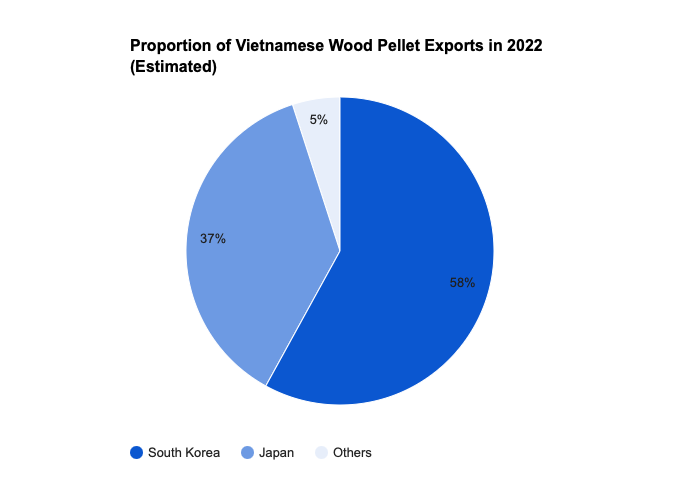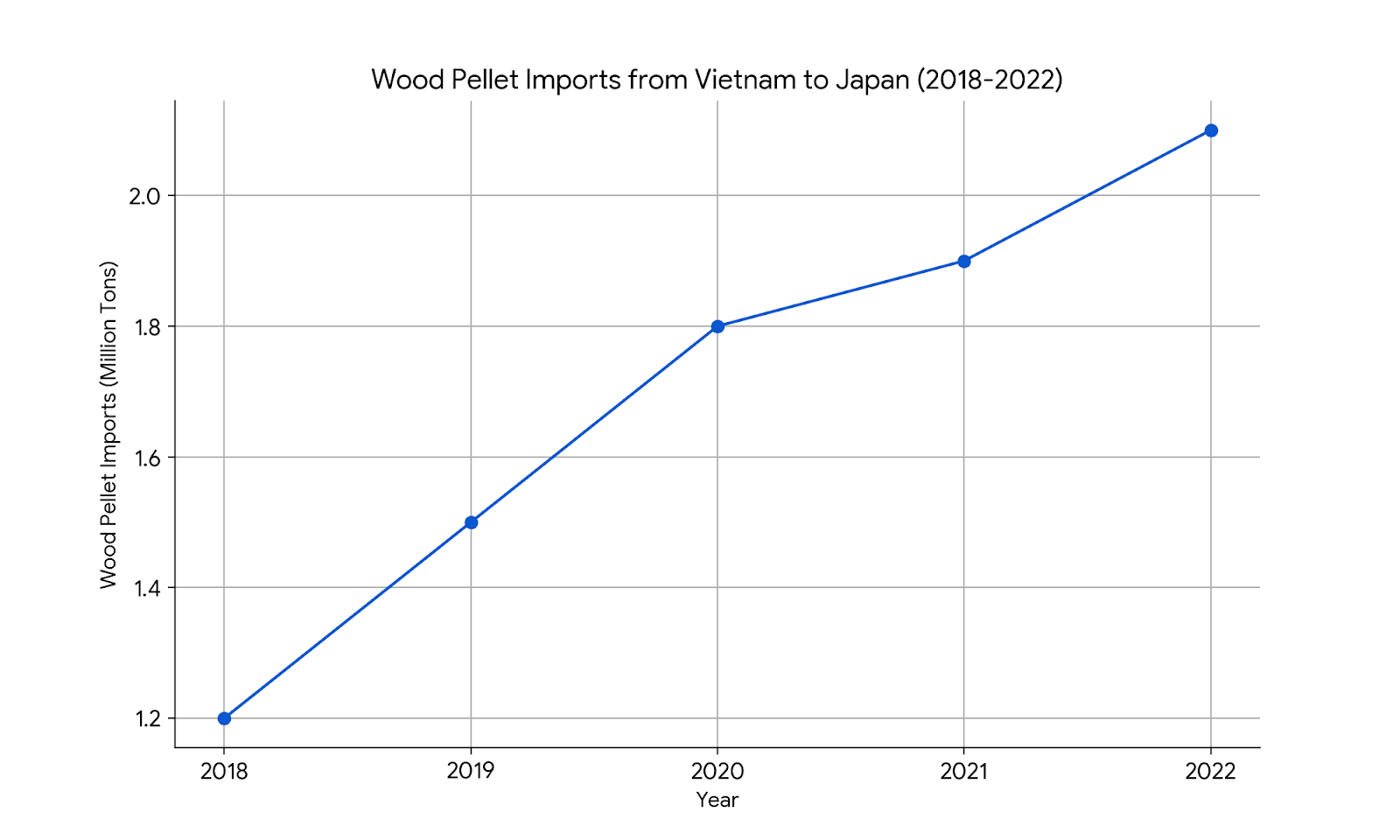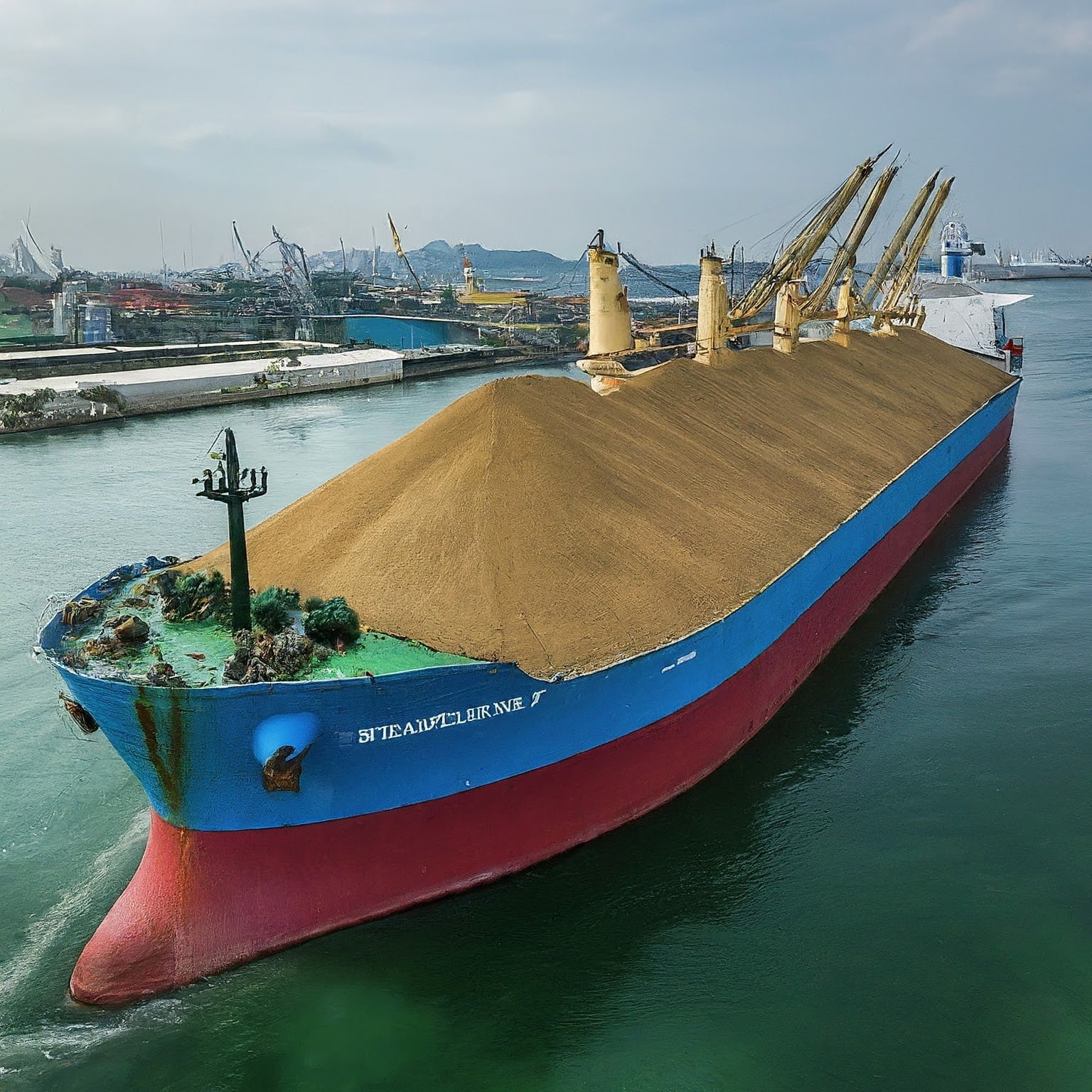Shipping Wood Pellets from Vietnam to Japan: A Comprehensive Overview
Market Overview
- Demand Surge: Japan’s dependence on fossil fuels has driven its demand for wood pellets. In 2022, Japan imported over 2 million tons of wood pellets from Vietnam, a significant increase from previous years [Source: Japan Wood Pellet Association (JWPA)].
- Vietnam’s Advantage: Vietnam boasts a thriving forestry industry and abundant resources, making it a cost-competitive supplier of wood pellets for Japan.
In recent years, Japan has seen a significant increase in the demand for wood pellets as a renewable energy source. As the country aims to reduce its reliance on fossil fuels and transition to more sustainable energy options, wood pellets have emerged as a viable solution. Wood pellets are a type of biomass fuel made from compressed sawdust and other wood waste materials. They are highly efficient and produce lower emissions compared to traditional fossil fuels.
The demand for wood pellets in Japan has been driven by several factors. Firstly, the government has implemented policies and incentives to promote the use of renewable energy sources, including biomass. This has created a favorable market environment for wood pellet producers and suppliers. Additionally, there is a growing awareness among consumers about the importance of reducing carbon emissions and transitioning to cleaner energy sources. As a result, many industries and households are actively seeking out sustainable alternatives like wood pellets.
However, meeting this increasing demand for wood pellets poses a challenge for Japan. The country does not have sufficient domestic production capacity to meet its needs, which has led to a reliance on imports. Therefore, finding reliable suppliers who can provide high-quality wood pellets in large quantities is crucial for Japan’s renewable energy goals.
Vietnam’s Role in the Global Wood Pellet Market
Vietnam has emerged as a major player in the global wood pellet market, with a rapidly growing industry that caters to both domestic and international demand. The country has abundant forest resources and a well-established timber industry, making it an ideal location for wood pellet production.
Vietnam’s wood pellet industry has experienced significant growth in recent years, driven by both domestic and international demand. The country has favorable climatic conditions for growing trees, which ensures a steady supply of raw materials for pellet production. Additionally, Vietnam has invested in modern manufacturing facilities and technologies, allowing for efficient and cost-effective production processes.
In terms of export, Vietnam has become one of the largest wood pellet suppliers in the world. The country exports wood pellets to various countries, including Japan, South Korea, and Europe. Vietnam’s competitive advantage lies in its ability to produce high-quality wood pellets at a lower cost compared to other countries. This has made it an attractive option for buyers looking for reliable and affordable wood pellet suppliers.

The Advantages of Shipping Wood Pellets from Vietnam to Japan
There are several advantages to shipping wood pellets from Vietnam to Japan. Firstly, Vietnam is geographically close to Japan, which makes transportation more convenient and cost-effective. The proximity allows for shorter shipping distances and reduces the time required for delivery. This is particularly important for perishable goods like wood pellets, as shorter shipping times help maintain their quality.
Moreover, shipping from Vietnam to Japan is more cost-effective compared to other countries. Vietnam has lower labor and production costs, which translates into competitive pricing for wood pellets. This is especially beneficial for Japan, as it allows them to import large quantities of wood pellets at a reasonable price.
In terms of quality, wood pellets produced in Vietnam are known for their high standards. Vietnamese manufacturers adhere to strict quality control measures and use advanced production technologies to ensure consistent quality. This is crucial for Japanese buyers who require reliable and high-quality wood pellets to meet their energy needs.

Challenges of Shipping Wood Pellets from Vietnam to Japan
While there are many advantages to shipping wood pellets from Vietnam to Japan, there are also several challenges that need to be addressed. One of the main challenges is the language and cultural barriers between Vietnamese and Japanese companies. Effective communication is essential for successful business transactions, but language differences can hinder this process. It is important for both parties to invest in translation services or hire bilingual staff to facilitate smooth communication.
Logistics and transportation pose another challenge when shipping wood pellets from Vietnam to Japan. Ensuring timely delivery and minimizing the risk of damage during transit requires careful planning and coordination. This includes selecting reliable shipping partners, optimizing shipping routes, and implementing proper handling and packaging procedures.
Compliance with regulations and permits is also a challenge when exporting wood pellets from Vietnam to Japan. Both countries have specific regulations and requirements for importing and exporting goods, and it is crucial to ensure compliance to avoid any legal issues or delays. This includes obtaining the necessary permits, certifications, and documentation for the shipment. Proper documentation (commercial invoices, packing lists, certificates of origin) is crucial forスムーズ (sumīzu, smooth) customs clearance in both Vietnam and Japan.
Transportation Options for Shipping Wood Pellets from Vietnam to Japan
There are several transportation options available for shipping wood pellets from Vietnam to Japan. The most common methods are sea freight and air freight.
Sea freight is the preferred option for large-scale shipments due to its cost-effectiveness. It allows for the transportation of large quantities of wood pellets in bulk containers. The shipping time for sea freight can vary depending on the distance and route, but it is generally longer compared to air freight. However, with proper planning and coordination, sea freight can be a reliable and efficient option for shipping wood pellets.

Air freight, on the other hand, is faster but more expensive compared to sea freight. It is suitable for smaller shipments or urgent deliveries. Air freight allows for quicker transportation, reducing the risk of spoilage or damage to the wood pellets. However, the higher cost associated with air freight may limit its use for large-scale shipments. This transportation option is mostly suited for delivering samples.
When choosing between sea freight and air freight, it is important to consider factors such as cost, delivery timeframes, and the specific requirements of the shipment.
Regulations and Permits Required for Exporting Wood Pellets from Vietnam to Japan
Exporting wood pellets from Vietnam to Japan requires compliance with specific regulations and permits. Both countries have their own set of requirements that need to be met to ensure smooth customs clearance and legal importation.
In Vietnam, exporters need to obtain an export license from the Ministry of Industry and Trade. This license is required for all goods being exported, including wood pellets. Additionally, exporters must comply with the regulations set by the Vietnam Administration of Forestry to ensure sustainable and legal sourcing of raw materials.
In Japan, importers need to obtain an import permit from the Ministry of Agriculture, Forestry, and Fisheries. This permit is necessary for the importation of wood pellets and ensures compliance with Japanese regulations and standards. Importers must also provide the necessary documentation, such as a bill of lading and a certificate of origin, to facilitate customs clearance.
It is important for both exporters and importers to familiarize themselves with the specific regulations and requirements of each country to avoid any delays or complications during the shipping process.
Quality Control Measures for Wood Pellets Shipping from Vietnam to Japan
Ensuring consistent quality is crucial when shipping wood pellets from Vietnam to Japan. Vietnamese manufacturers have implemented strict quality control measures to meet the high standards required by Japanese buyers.
Quality control starts at the production stage, where manufacturers use advanced technologies and equipment to produce high-quality wood pellets. This includes proper drying and processing techniques to ensure the pellets have the right moisture content and density. Manufacturers also conduct regular quality checks during production to identify any defects or inconsistencies.
In addition to production quality control, Vietnamese manufacturers also implement strict packaging and handling procedures. Wood pellets are typically packaged in durable bags or containers that protect them from moisture and damage during transit. Proper handling techniques are also employed to minimize the risk of breakage or contamination.
Furthermore, Vietnamese manufacturers often undergo third-party certifications and audits to validate their quality control processes. These certifications provide assurance to Japanese buyers that the wood pellets meet the required standards and specifications.
Packaging and Handling of Wood Pellets for Safe Shipping
Proper packaging and handling are essential for safe shipping of wood pellets from Vietnam to Japan. Wood pellets are fragile and can easily break or crumble if not handled correctly. Therefore, it is important to use appropriate packaging materials and techniques to protect the pellets during transit.
Wood pellets are typically packaged in durable bags made of woven polypropylene or plastic. These bags are designed to withstand the rigors of transportation and protect the pellets from moisture and contamination. The bags are often sealed with heat or stitching to ensure they remain intact during transit.
In addition to proper packaging, handling procedures should be followed to minimize the risk of damage. This includes using appropriate lifting equipment and techniques to avoid dropping or mishandling the bags. It is also important to store the wood pellets in a dry and well-ventilated area to prevent moisture absorption.
By implementing proper packaging and handling procedures, the risk of damage or spoilage during shipping can be minimized, ensuring that the wood pellets arrive in Japan in good condition.
Cost Analysis of Shipping Wood Pellets from Vietnam to Japan
The cost of shipping wood pellets from Vietnam to Japan can vary depending on several factors. These include the transportation method, shipping distance, volume of the shipment, and any additional services required.
Sea freight is generally more cost-effective compared to air freight for large-scale shipments. The cost of sea freight is calculated based on factors such as container size, weight, and shipping distance. Additionally, there may be additional charges for services such as customs clearance and port handling fees.
Air freight, on the other hand, is more expensive but offers faster delivery times. The cost of air freight is calculated based on factors such as weight, volume, and destination airport. Additional charges may apply for services such as customs clearance and handling fees.
Other factors that can affect the cost of shipping wood pellets include fuel prices, currency exchange rates, and any applicable taxes or duties. It is important for both exporters and importers to carefully consider these factors when calculating the overall cost of shipping.
Environmental Impact of Shipping Wood Pellets from Vietnam to Japan
While wood pellets are considered a renewable energy source, the shipping process does have an environmental impact. This includes carbon emissions from transportation and concerns about deforestation.
Shipping wood pellets from Vietnam to Japan involves the burning of fossil fuels, which contributes to carbon emissions. The amount of emissions generated depends on the transportation method and distance. Sea freight generally has lower emissions compared to air freight, as ships are more fuel-efficient. However, efforts should still be made to minimize emissions by optimizing shipping routes and using more sustainable fuels.
Another environmental concern is deforestation. Wood pellets are made from sawdust and other wood waste materials, but there is a risk of unsustainable logging practices if demand exceeds supply. It is important for both Vietnam and Japan to ensure that the wood used for pellet production comes from sustainable sources and does not contribute to deforestation.
To mitigate these environmental impacts, efforts are being made to promote sustainable practices in the wood pellet industry. This includes sourcing wood from certified sustainable forests, investing in fuel-efficient transportation methods, and exploring alternative energy sources for shipping.
Future Prospects for Shipping Wood Pellets from Vietnam to Japan
The shipping of wood pellets from Vietnam to Japan presents both advantages and challenges. Vietnam’s position as a major wood pellet producer and exporter, coupled with its proximity to Japan, makes it an attractive option for meeting Japan’s growing demand for renewable energy sources.
However, there are challenges that need to be addressed, such as language barriers, logistics, and compliance with regulations. By overcoming these challenges through effective communication, careful planning, and adherence to regulations, the shipping process can be streamlined and successful.
The future prospects for shipping wood pellets from Vietnam to Japan look promising. As Japan continues to prioritize renewable energy sources and reduce its reliance on fossil fuels, the demand for wood pellets is expected to grow. This presents an opportunity for Vietnamese manufacturers to expand their production capacity and meet this increasing demand.
It is important for both Vietnam and Japan to work together to ensure sustainable practices in the wood pellet industry. This includes promoting responsible sourcing of raw materials, investing in fuel-efficient transportation methods, and implementing quality control measures to ensure consistent and high-quality wood pellets.
By addressing the challenges and embracing sustainable practices, the shipping of wood pellets from Vietnam to Japan can contribute to the transition towards a cleaner and more sustainable energy future.
Originally posted 2024-04-12 22:40:39.







